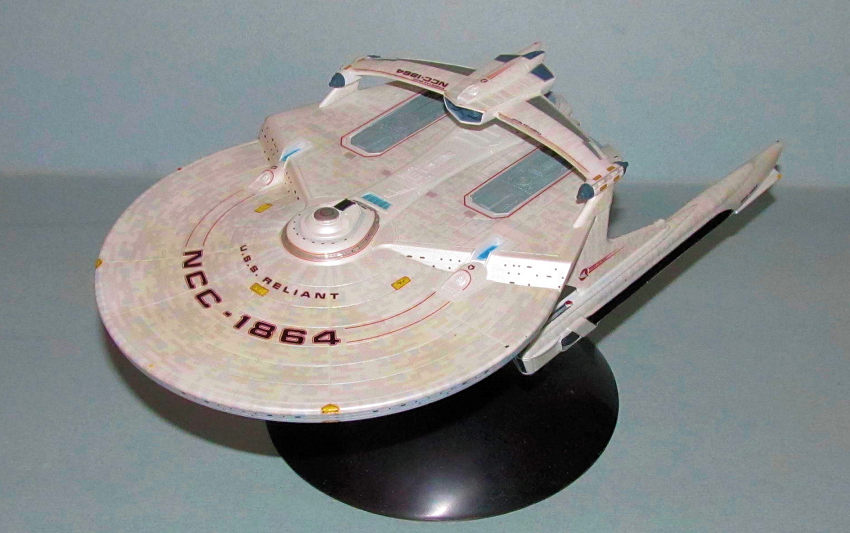
Polar Lights 1/1000 USS Reliant
| KIT #: | POL 906 |
| PRICE: | $29.99 SRP |
| DECALS: | Several options |
| REVIEWER: | Dan Lee |
| NOTES: | Polar Lights Aztec Decal Sheet for the Reliant and Paragrafix PE set.. |

| HISTORY |
The USS Reliant was originally built as an Anton Class light cruiser. The Anton class' primary function was to act as an exploration vessel in a similar role to the Constellation Class heavy cruiser. However, it was lightly armed with just two phaser banks and not supposed to be used in high threat areas or as a front line unit in times of war. This changed during the Four Years War with the Klingons when the Antons were pressed into combat and suffered heavy losses because of its weak armament and shields.
Star Fleet decided that the Antons needed upgrading as
exploration proved to be more hazardous than expected and to give Star Fleet
more capable cruisers to deal with the increased threats from both the Klingon
and Romulan empires. The addition of a sensor and weapons roll bar added bow and
stern photon torpedoes as well as additional phasers to give the Antons more
firepower and sens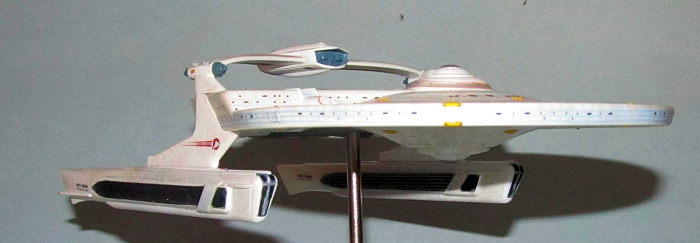 or
capability as well as deal with the stern blindspot. It was decided to name the
upgraded Anton Class cruisers after the USS Reliant which was the first ship to
be upgraded.
or
capability as well as deal with the stern blindspot. It was decided to name the
upgraded Anton Class cruisers after the USS Reliant which was the first ship to
be upgraded.
The Reliant became famous or infamous after the Genesis Incident in which the Reliant was taken over by 20th century dictator Khan Noonian Singh and his followers during a classified exploration mission to Ceti Alpha VI (which actually turned out to be Ceti Alpha V.) It was heavily damaged in the clash with the USS Enterprise commanded by Admiral James T. Kirk and destroyed when the Genesis device it carried was detonated in the middle of the Mutara Nebula as recounted in the movie Star Trek II: The Wrath of Khan.
Info from the FASA's Star Trek Role Playing Game's Federation Starship Manual.
Most Star Trek fans know this ship as a member of the Miranda class rather than Anton which was the name used in the FASA Star Trek role playing game.
| THE KIT |
The 1/1000 scale kit from
Polar Lights is a snap together kit. It consists of two white plastic main hull
pieces, two white plastic sprues that include the warp engines/roll bar/detail
parts and one clear sprue for the clear parts (naturally.) There is a decal
sheet with the main markings and some windows as well as a metal rod, plastic
stand and extra black plastic parts for the stand. The detail is o kay
if not oversized for the scale and there is minimal flash on the parts. The
clear parts are clear and full of detail.
kay
if not oversized for the scale and there is minimal flash on the parts. The
clear parts are clear and full of detail.
It contains a decal sheet that has the minimum amount of markings and windows. The additional Polar Lights sheet contains an entire set of Aztec markings from stem to stern, markings missing from the kit sheet that were supposed to be painted on based on the kit instructions as well as the ID markings for several different “Miranda” Class ships as seen in the movies including the Saratoga (Star Trek IV: The Voyage Home) and others encountered by the Enterprise-D in Star Trek: The Next Generation.
| CONSTRUCTION |
I started off by gluing together the parts for the engine pylons and weapons roll bar. Next I glued together the main hull and immediately ran into trouble. The hull sidewalls did not line up with the top of the hull. Instead of persevering and filling/sanding the gaps, I threw the kit into the box and it sat for almost a year. I realize that part of my problem was that I mistakenly assumed that this snap kit would be more like the Polar Lights Romulan Warbird and Bandai Star Wars “snap together” kits I was building at the time AND not like the 1/1000 Polar Lights USS Enterprise (the original series) which 10 years earlier had turned me into a hammer waving spazz.
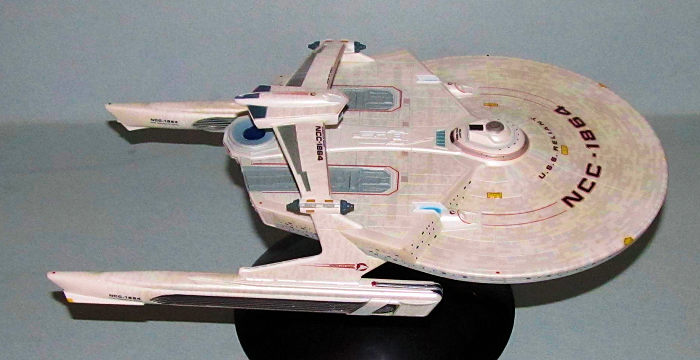 I
returned to the kit after I realized my “started” pile was more than the number
of kits I had finished during the year.
I
returned to the kit after I realized my “started” pile was more than the number
of kits I had finished during the year.
The aforementioned seams along the upper side of the stern main hull were filled and sanded many times while the circular portion of the main hull fit much better and only some slight sanding was required. I added the Paragrafix PE as per instructions. I left off many details because they were more of a headache than an enhancement. Next to be filled and sanded were the pylons and weapons roll bar with photon torpedo pod. The photon torpedo pod itself required some careful filling and sanding as the gaps were large and awkward to deal with. I filled in the areas I could not sand easily with Vallejo plastic putty and removed the excess material with damp Q-Tips.
I did not assemble the entire ship because painting and decaling it would be very difficult if I did and I wasn't going to make that stupid mistake again. I clipped off most of the engine pylon mounting tabs (for the warp engines) because if I didn't then I couldn't add them till later as they were designed to be added to the engine pylons first.
The engines were assembled after rest of the ship was painted and decaled. The bow inserts for the warp engines were painted as per instructions (flat black and flat white ) several months earlier. I added them to the warp engines which were glued together, shoved into a box for a couple of weeks to let the glue cure to eliminate phantom seams then filled with CA glue and sanded with various grades of sandpaper to smooth everything out.
| COLORS & MARKINGS |
Like most Star Trek models,
the painting is complex because of the shapes and that damned Aztec pattern
paint scheme. As maybe those few who read my build reviews know, I would prefer
to avoid dealing with the Aztec scheme whether it is via paint or decals, but I
can't. It is the bane of my existence as a science fiction modeller. Polar
Lights sells (not provides) an Aztec decal set for the Reliant which I ob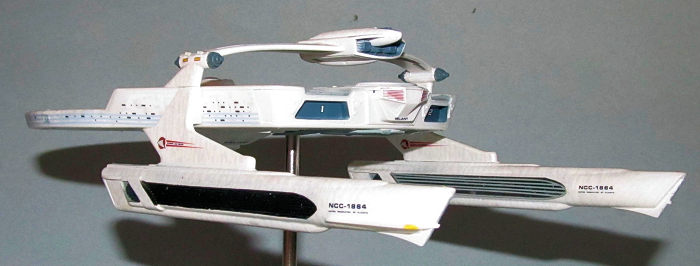 tained.
I had some (painful) experience with similar sets and decided to be smart (or at
least attempt to be smarter) about dealing with the paint and decals.
tained.
I had some (painful) experience with similar sets and decided to be smart (or at
least attempt to be smarter) about dealing with the paint and decals.
I first sprayed on Tamiya flat white acrylic paint to provide a base color as well as act as a primer for the pearl coat. When the white was dry to the touch, I sprayed on a couple of thin coats for Testors Artist Arcylic White Pearl over the white paint. It was already thinned for airbrush so no extra thinning required. It looked good and subtle, but the surface was grainer than I wanted for the decals so I rubbed it with various grades of sanding cloth, but thanks to some over vigorous sanding I had to spray flat white and then white pearl again.
I then had to mask off the white pearl areas of the main hull and spray on the various colors (Sky Blue, Light Blue (close to duck egg blue) and Yellow for the phaser mounts. I discovered to my dismay that I didn't cover enough areas with Tamiya flat white to act as a primer for the pearl white which lifted so I had to repaint those areas.
Certain areas of the roll bar/weapons pod were masked and painted light grey, light blue and intermediate blue as per the instructions. The hardest areas to mask were the front and rear faces of the photon torpedo tubes. Any areas that had overspray were lightly polished with a 3200 grit polishing cloth to remove the mistakes. Everything was sealed in with two light coats of Future which acted as the gloss coat in preparation for the decals.
I started by applying the
Aztec decals first. I did it in a methodical order rather than randomly putting
the decals on as I did in the past. Top part of the saucer first followed by the
stern deck. Once dry, I put on the port and starboard side decals and then
flipped the main hull over. The bottom saucer decals were added.
The roll bar decals were more problematic because of the surface detail which didn't allow the decals to conform to the surface properly. I had to deal with a number of persistent air bubbles and used Solvaset to force the decals to nestle deep into the detail.
I vaguely remembered that the decals for the phaser banks were a pain in the rear from my experience with the USS Enterprise Refit build AFTER I put on the lower hull decals. I measured and then marked off the areas where the phaser nozzles stood out and used a sharp knife to drill holes through the decals. I then added the decals to the sheet and I only needed one application of Solvaset to get the decal to snuggle over the detail instead of three/four.
The warp engines were done later. They were more difficult due to the odd angled surfaces and various surface protrusions. Several repeated applications of Solvaset were used to get rid of most of the decal bubbles. I wiped down the model prior to the final coat to remove any excess decal solution. No weathering was done. I sprayed on a light coat of Xtracrylix Satin Coat on everything to deal everything in.
| FINAL BITS |
I discovered that I had to trim the warp engine pylons mounting tabs to allow the them to connect into the main hull without too much trouble. I ran a thin line of Tamiya Extra Thin cement to secure the pylons in place.
The weapons/sensor roll bar
was added to the engine pylons and I discovered that I had a noticeable gap bet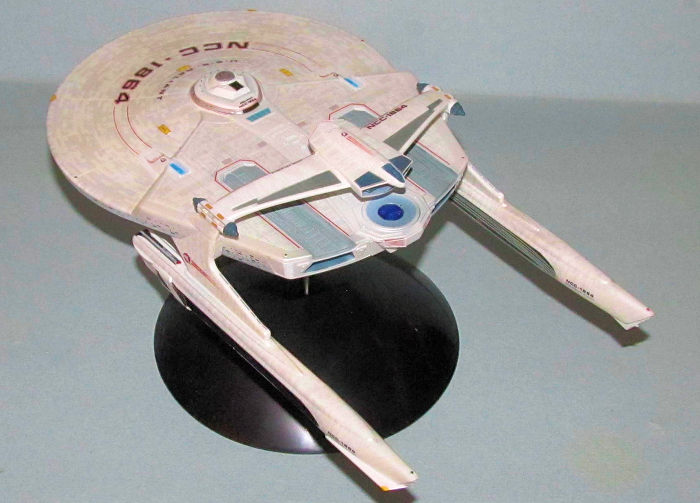 ween
the roll bar and the inside area of both engine pylons. A thin line of Vallejo
plastic putty filled the gap up and the excess removed using damp Q-Tips.
ween
the roll bar and the inside area of both engine pylons. A thin line of Vallejo
plastic putty filled the gap up and the excess removed using damp Q-Tips.
The bridge and bottom sensor array were added after painting and decals. I glued the painted phaser nozzles at the ends of the roll bar to secure the roll bar in place. It was at this point I added many of the remaining decals.
I added tiny dabs of Kristal Kleer to replace any lights that I had sanded off in the construction process. Once dry, I painted the portside lights green and the starboard lights red as per instructions using a toothpick dipped in paint. Next I added the impluse engineer clear pieces (which weren't so clear as I painted them red) and the Paragrafix PE screens using Krystal Klear. I also brush painted certain details on the warp engines.
Lastly I glued the warp engines on using some Tamiya extra thin glue and a couple of dabs of CA glue to hold them into place. Once they were secure enough, I added the Reliant to the stand and I was finished.
| CONCLUSIONS |
The Polar Lights USS Reliant is not an easy to build snap kit (at least for a beginner.) It can make a nice model straight from the box with careful work especially in regards to painting, but the added Aztec decals make the model stand out and require a lot of extra work and patience. I was kind of disappointed that I didn't really need most of the Paragrafix PE set, but the parts I did use were very good.
I enjoyed this build a lot more than I enjoyed the 1/1000 Polar Lights Enterprises (both the original and the movie refit version) although I everything did to this kit was based on my experience building both of them.
5 September 2017
Copyright ModelingMadness.com
If you would like your product reviewed fairly and fairly quickly, please contact the editor or see other details in the Note to Contributors.
Back to the Main Page Back to the Review Index Page Back to the Previews Index Page